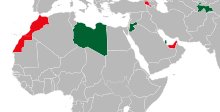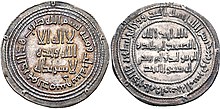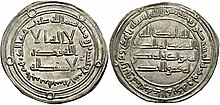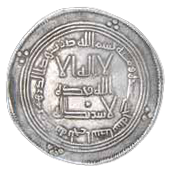Dirham






The dirham, dirhem or drahm (
Unit of mass
The dirham was a unit of weight used across North Africa, the Middle East, Persia and
The value of Islamic dirham was 14 qirat. 10 dirham equals 7 mithqal (2.975 gm of silver).
In the late Ottoman Empire (
In
There is currently a movement within the Islamic world to revive the dirham as a unit of mass for measuring silver, although the exact value is disputed (either 3 or 2.975 grams).[3]
History
The word "dirham" ultimately comes from
Dirham in Jewish orthodox law
The dirham is frequently mentioned in
The word drachmon (Hebrew: דרכמון), used in some translations of Maimonides' commentary of the Mishnah, has in all places the same connotation as dirham.[12]
Modern-day currency
Currently the valid national currencies with the name dirham are:
| Countries | Currency | ISO 4217 code |
|---|---|---|
| Moroccan dirham | MAD | |
| United Arab Emirates dirham | AED | |
| Armenian dram | AMD |
Modern currencies with the subdivision dirham or diram are:
| Countries | Currency | ISO 4217 code | Subdivision |
|---|---|---|---|
| Libyan dinar | LYD | Dirham | |
| Qatari riyal | QAR | Dirham | |
| Jordanian dinar | JOD | Dirham | |
| Tajikistani somoni | TJS | Diram |
The unofficial modern gold dinar, issued and/or proposed by several states and proto-states, is also divided into dirhams.
See also
References
- ^ based on an oka of 1.2828 kg; Diran Kélékian gives 3.21 g (Dictionnaire Turc-Français, Constantinople: Imprimerie Mihran, 1911); Γ. Μπαμπινιώτης gives 3.203 g (Λεξικό της Νέας Ελληνικής Γλώσσας, Athens, 1998)
- OED
- from the original on 2024-01-02. Retrieved 2019-11-20.
- ^ Oxford English Dictionary, 1st edition, s.v. 'dirhem' Archived 2020-02-09 at the Wayback Machine
- ^ BBC Art of Persia
- ^ In addition to Islamic dirhams in ninth and tenth century English hoards, a counterfeit dirham was found at Coppergate, in York, struck as if for Isma'il ibn Achmad (ruling at Samarkand, 903-07/8), of copper covered by a once-silvery wash of tin (illustrated in Richard Hall, Viking Age Archaeology, [series Shire Archaeology] 2010:17, fig. 7).
- ^ Mishnah – with a Commentary of Rabbi Moses ben Maimon, ed. Yosef Qafih, vol. 2 – Seder Neziqim, pub. Mossad Harav Kook: Jerusalem 1965, p. 189 (Hebrew title: משנה עם פירוש הרמב"ם)
- ^ Mishnah – with a Commentary of Rabbi Moses ben Maimon (ed. Yosef Qafih), vol. 3, Mossad Harav Kook: Jerusalem 1967, s.v. Introduction to Tractate Menahoth, p. 68 (note 35) (Hebrew)
- ^ Ovadiah Yosef, Sefer Halikhot ʿOlam, vol. 1, Jerusalem 2002 (Hebrew title: ספר הליכות עולם)
- ^ Ovadiah Yosef, Sefer Halikhot ʿOlam, vol. 1, Jerusalem 2002, p. 288, sec. 11; Abraham Chaim Naeh, Sefer Kuntres ha-Shi'urim Archived 2017-04-24 at the Wayback Machine, Jerusalem 1943, p. 4 (Hebrew)
- OCLC 762505465
- ^ Mishnah – with a Commentary of Rabbi Moses ben Maimon, ed. Yosef Qafih, vol. 3 – Seder Kodashim, pub. Mossad Harav Kook: Jerusalem 1967, s.v. Introduction to Tractate Menahoth, p. 68 (note 35) (Hebrew title: משנה עם פירוש הרמב"ם)
